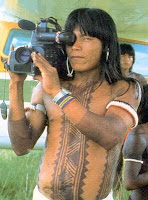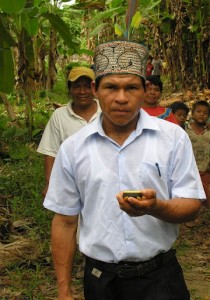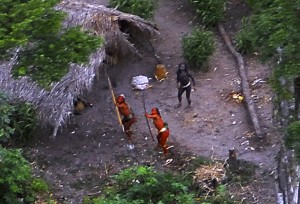 |
Indigenous people all over the world are already embedded in global modernity, whether anyone likes it or not. There is no turning back, no way to disengage from the modern world, nowhere for indigenous peoples to retreat. And I think it is fair to say that indigenous people are, generally, worse off in many ways since this change than they were before.
Still, there are aspects of modernity — modern dentistry, for example — which could be of benefit to indigenous people if they had access to them. Indeed, modern technologies can be appropriated by indigenous peoples for their own purposes — for example, in the Amazon, using video as a tool for perpetuating and reaffirming cultural values, or using Google Earth imaging to spot river discoloration caused by illegal mining operations, or using GPS mapping to determine traditional land boundaries.
 |
Very few indigenous peoples of the Upper Amazon hunt with blowguns any more. The weapon of choice is a 16-gauge shotgun, which provides a very efficient way to hunt medium-size jungle game — tapir, capybara, agouti, peccary, monkey. But there is a price. Hunting with a shotgun creates dependency on manufactured goods: shotgun shells cannot be made and must be bought.
Similarly, many mestizos hunt at night, floating silently downriver in a canoe with a shotgun and a flashlight. When they pass a beach where animals come to drink at night, they shine the light, and then fire at the eyeshine — indeed, they can even identify the species by the color of the reflection off the retina. But now they need not only shotgun shells but also flashlight batteries. Given the success of these hunting methods, despite their costs, I think it unlikely that Amazonian peoples will revert to traditional blowgun hunting.
 |
A while back I referred to first contact being made with a group of previously unknown indigenous inhabitants of the jungle between Peru and Brazil, based on what EarthFirst! called, at the time, “amazing photographs of one of the last uncontacted tribes in the Amazon.” Like others, I just swallowed whole the idea that these were in fact a previously uncontacted people, which, of course, turns out to have been something of a scam. As both The Guardian and National Geographic report, the tribe has in fact been known for almost a century, and the allegedly chance encounter that produced the now famous photographic images — red- and black-painted indigenes aiming their arrows at the airplane — were no accident.
José Carlos Meirelles, an official with FUNAI, Brazil’s Indian-protection agency, said that the tribe had monitored for decades, and that he intentionally flew over the area where the tribe is known to live in an attempt to get a photograph. He wanted, he said, to rebut claims that there are no isolated tribes left in the world, and to call attention to the danger facing them in the form of outside contact. “We put the photos out because if things continue the way they are going, these people are going to disappear,” he said.
Meirelles released the photos through the indigenous-rights advocacy group Survival International. “These pictures are further evidence that uncontacted tribes really do exist,” said Survival International director Stephen Corry. “The world needs to wake up to this, and ensure that their territory is protected in accordance with international law. Otherwise, they will soon be made extinct.” Survival International defended the intrusion on the tribe, saying that release of the images, and the subsequent international media attention, had forced Peru to re-examine its logging policy in the border area where the tribe lives.
There are multiple levels of irony here. Despite the alleged threats, the population of the tribe has nearly doubled in the last twenty years. Flying over the village and its inhabitants was certainly itself a form of contact, and it is unclear to me whether such contact can be justified because it makes a defensible political point. At the same time, Survival International is an outstanding organization that has done a tremendous amount of good for tribal peoples throughout the world.
Savage Minds, an anthropology blog, has considered the whole issue of uncontacted tribes, and has concluded that there is no such thing, at least not any more. The peoples described on Survival International’s website as uncontacted have all beein touch with outsiders for many years. As the blog puts it, “None of the people listed on the ‘uncontacted tribes’ are, according to SI’s own material, actually uncontacted in any straightforward sense of the term. The problem they face is exactly the fact that they are in contact with a world that is giving them the shortest end of the stick possible.”
The issue may be semantic. Survival International appears to have stipulatively redefined the term uncontacted. On the Survival International blog, the organization parses the term uncontacted as meaning “has no peaceful contact with outsiders.” Under this definition, an indigenous people that has been slaughtered and driven deeper into the jungle by gold miners is uncontacted.
I think our romantic image of pristine and uncontacted indigenous peoples is, in the twenty-first century, a mirage. We can no longer console ourselves with the thought that there are some who have evaded our grasp. We are all in this together. The question is what we are going to do about it.

- Previous Post: Moses and Ayahuasca
- Next Post: Uncontacted Tribes Again
- More Articles Related to: Indigenous Culture, The Amazon



Hello, my name is Andy Graham of HoboTraveler.com Travel Blog. My blog is on Forbes.com, About.com, New York Time, Budget Travel, Guardian and huge amount of other sites. I am serious person, I am in Pucallpa, Peru presently (January 13, 2009) and I planning a trip to Breu a village on the Yurua river near the location of the lesser contacted tribes, I do not want to disturb them I wish to study the culture as I get closer. I need help, opinion and interested magazines or newspapers. Thanks from Andy of HoboTraveler.com Un-contacted Tribes and my Travel Blog here is how to contact me: Contact Andy of HoboTraveler.com
Dear Steve,
I offer a few remarks to complement your post. Firstly, the distribution of photos of an uncontacted tribe was not a scam, although that was the portrayal of it by some elements of the media.
When Survival published the photos, we quoted José Carlos dos Reis Meirelles, the Brazilian official who released them, saying, “We did the overflight to show their houses, to show they are there…” As Mr Meirelles said when the Brazilian government released the photos, the Indians’ territory has been monitored for 20 years:
http://www.survival-international.org/news/3400
The Observer, who published the ‘hoax’ article you linked to, has since conceded that its reporting of the so-called hoax was ‘inaccurate, misleading [and] distorted’:
http://www.guardian.co.uk/commentisfree/2008/aug/31/voluntarysector
Secondly, it’s worth responding to the suggestion that Survival’s use of the word ‘uncontacted’ means we perpetuate a romantic ‘mirage’ of some communities.
It is obvious that, given the history of the human species, every human group had contact with other groups at some point, but it is clearly not this sense of ‘contact’ that we refer to in the case of these peoples.
The peoples in question are likely to have had no peaceful contact with anyone other than immediate tribal neighbours for generations. They may have had fleeting, violent encounters with trespassers over the years, but they have remained, to all intents and purposes, out of contact with societies other than their own.
One last point, regarding the idea of ‘modernity’. This is an unfortunate term, having the effect of implying that indigenous peoples are ‘not modern’ or ‘dated’. Survival considers it more correct to note that all societies, tribal and otherwise, change and develop, albeit in their own way, and are therefore modern. To suggest otherwise can be dangerous, and provides fuel for those who argue that indigenous lifestyles are ‘primitive’ and ripe for interventions from outside. Such intervention, as you note, leaves tribal peoples, “generally, worse off in many ways…than they were before.”
Sincerely,
Matt, Survival International,
http://www.survival-international.org
Thank you for your most helpful comment. I have for many years been a supporter of Survival International, which is, as I pointed out in the post, an outstanding organization that has done a tremendous amount of good for tribal peoples throughout the world.
And I entirely agree with your concern about the term modernity, although I am not sure what we should use as a substitute. In fact, I speak here about the "odd affectation of European colonialism that indigenous people are without history — that, unlike Europeans, they are unchanging in their isolation and innocence."
But if indigenous peoples have been harmed by the contemporary world, it is also true that the contemporary world provides tools with which to fight back — including the tool of publicity, as I note here. I think that the romantic image of the uncontacted tribe may, in the past, have been an effective use of this tool. But it may well be that it is time to focus on the real — and unromantic — harms of contact.
I don't think there is any question that we are in agreement about the severity of those harms.
Again, thank you participating in this discussion. Please feel free to wander through the rest of the blog.
And now? Feb 1, 2011?
http://www.google.com/hostednews/afp/article/ALeqM5i4kAQzbepX3OMCJVut0wfV771aFw
FUNAI is using the same photos, again? c’mon, the machette, the cooking pot….not contacted for generations?
Is survival international really still using words like “contacted”? A bit sensational, to say the least.
I’ve just asked my local MP to support the international law to protect these amazing tribes people, wether they chose to be in contact with outsiders are not, if we are arming with weapons or other manufactured things we are probably acelerating their decline. I would like to see more done to prevent the violence and other nasty ways of our so called progress spoiling their own progress.